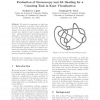Free Online Productivity Tools
i2Speak
i2Symbol
i2OCR
iTex2Img
iWeb2Print
iWeb2Shot
i2Type
iPdf2Split
iPdf2Merge
i2Bopomofo
i2Arabic
i2Style
i2Image
i2PDF
iLatex2Rtf
Sci2ools
CGVR
2007
2007
Evaluation of Stereoscopy and Lit Shading for a Counting Task in Knot Visualization
We present an experiment on depth cues for knot visualization in desktop virtual reality (fishtank VR). We used a within-subjects experiment to investigate stereoscopic visuals and 3D lit shading. Participants were required to count crossings in visualized knots – a fundamental task in classical knot diagram interpretation. Participants made significantly more errors with stereoscopic visuals than with monoscopic visuals, while no effect was detected for shading. Since this contrasts evaluations of fishtank VR for other applications, it provides knowledge about limitations of stereo imaging. In addition to the experiment, we outline our knot visualization approach, which uses a dynamic simulation and charged rope analogy to generate knot shape, and includes a technique for rendering gaps like those found in classical knot diagrams.
| Added | 29 Oct 2010 |
| Updated | 29 Oct 2010 |
| Type | Conference |
| Year | 2007 |
| Where | CGVR |
| Authors | Nicholas G. Lipari, Christoph W. Borst |
Comments (0)

